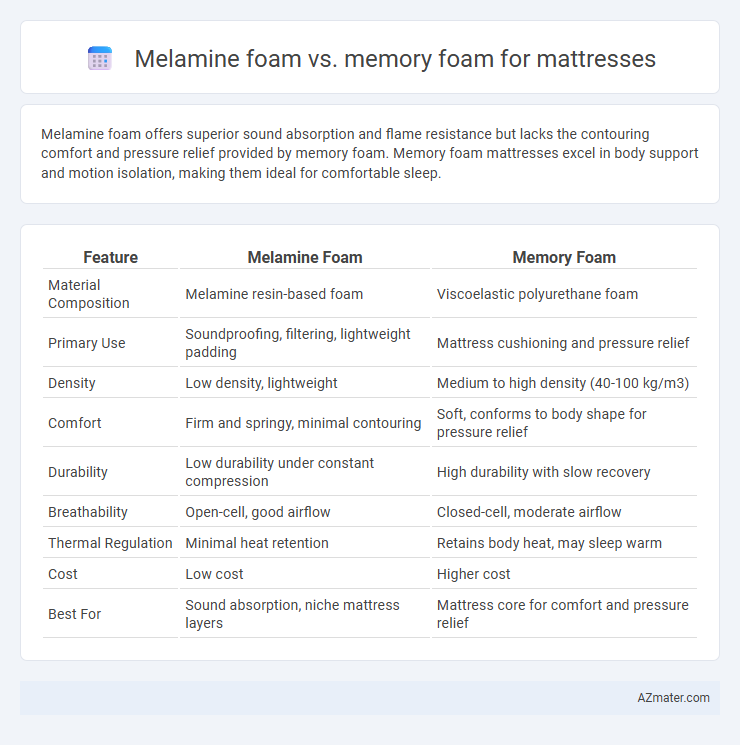Melamine foam offers superior sound absorption and flame resistance but lacks the contouring comfort and pressure relief provided by memory foam. Memory foam mattresses excel in body support and motion isolation, making them ideal for comfortable sleep.
Table of Comparison
| Feature | Melamine Foam | Memory Foam |
|---|---|---|
| Material Composition | Melamine resin-based foam | Viscoelastic polyurethane foam |
| Primary Use | Soundproofing, filtering, lightweight padding | Mattress cushioning and pressure relief |
| Density | Low density, lightweight | Medium to high density (40-100 kg/m3) |
| Comfort | Firm and springy, minimal contouring | Soft, conforms to body shape for pressure relief |
| Durability | Low durability under constant compression | High durability with slow recovery |
| Breathability | Open-cell, good airflow | Closed-cell, moderate airflow |
| Thermal Regulation | Minimal heat retention | Retains body heat, may sleep warm |
| Cost | Low cost | Higher cost |
| Best For | Sound absorption, niche mattress layers | Mattress core for comfort and pressure relief |
Introduction to Melamine Foam and Memory Foam
Melamine foam is an open-cell foam made from melamine resin, known for its lightweight structure and superior sound absorption properties. Memory foam, composed of viscoelastic polyurethane, is renowned for its ability to contour to the body by responding to heat and pressure, providing enhanced support and pressure relief. Both materials offer distinct benefits for mattresses, with melamine foam primarily used for noise reduction and memory foam focused on comfort and ergonomic support.
Composition and Material Differences
Melamine foam, primarily composed of a melamine-formaldehyde resin, is a rigid, open-cell structure known for its excellent sound absorption and thermal insulation properties, whereas memory foam is a viscoelastic polyurethane foam designed to contour closely to the body by responding to heat and pressure. Melamine foam is lightweight, fire-resistant, and typically used in construction and acoustic treatments, while memory foam's dense, flexible material is engineered for comfort and support in mattress applications. The chemical composition differences result in melamine foam being less resilient and softer, contrasting with memory foam's durable elasticity and slow recovery characteristics.
Comfort and Support Comparison
Melamine foam offers lightweight cushioning with excellent sound absorption but lacks the contouring support memory foam provides, making it less ideal for mattress comfort. Memory foam delivers superior pressure relief by conforming closely to body curves, promoting spinal alignment and reducing motion transfer. For mattresses, memory foam is preferred due to its balanced comfort and orthopedic support, while melamine foam is more suited for insulation and acoustic purposes.
Durability and Longevity
Melamine foam offers high durability due to its rigid cellular structure, making it resistant to compression and deformation over time. Memory foam, while providing superior comfort and pressure relief, tends to lose its resilience faster due to repeated use, which may result in sagging and reduced support. For mattresses, memory foam usually requires higher-density formulations to enhance longevity, whereas melamine foam's inherent toughness supports extended durability without significant breakdown.
Breathability and Temperature Regulation
Melamine foam offers superior breathability due to its open-cell structure, which allows better air circulation and prevents heat buildup. Memory foam, while known for conforming to body shape, tends to retain heat because of its dense, closed-cell composition, leading to less effective temperature regulation. Choosing melamine foam mattresses enhances cooler sleep environments, ideal for hot sleepers, whereas memory foam mattresses may require added cooling technologies to improve airflow and comfort.
Safety and Health Considerations
Melamine foam is primarily used as a soundproofing and cleaning material, not as a mattress component, and lacks certifications for prolonged skin contact or pressure redistribution, raising concerns over irritation and allergenic potential. Memory foam mattresses contain viscoelastic polyurethane foam designed to relieve pressure points and provide support, often treated with fire retardants that can emit volatile organic compounds (VOCs), potentially affecting indoor air quality. Consumers should prioritize CertiPUR-US or OEKO-TEX certified memory foam mattresses to ensure low chemical emissions and hypoallergenic properties, promoting safer sleep environments.
Price and Cost-Effectiveness
Melamine foam mattresses generally have a lower initial price compared to memory foam options due to inexpensive production processes and materials. Memory foam offers superior durability and pressure relief, which can result in better long-term cost-effectiveness despite a higher upfront investment. Evaluating factors such as lifespan, comfort, and maintenance expenses helps determine the best value for individual mattress needs.
Common Uses in Mattresses
Melamine foam is primarily used in mattresses for its soundproofing and insulation properties, often incorporated as a supportive layer to enhance breathability and comfort. Memory foam, known for its contouring ability and pressure relief, is the preferred choice in mattresses to provide personalized support and improve sleep quality. While melamine foam is more common in specialty mattresses requiring fire resistance and durability, memory foam dominates in comfort-focused mattress designs.
Pros and Cons of Melamine Foam vs Memory Foam
Melamine foam offers excellent sound absorption and fire resistance, making it a suitable choice for noise reduction and safety, but it lacks the cushioning and pressure relief properties of memory foam. Memory foam provides superior comfort, body contouring, and spinal support, ideal for mattress use, though it often retains heat and may off-gas odors initially. Choosing between melamine and memory foam depends on the primary need: acoustic and fire safety benefits from melamine foam or ergonomic comfort and sleep support from memory foam.
Choosing the Right Foam for Your Mattress
Melamine foam offers excellent sound absorption and flame resistance, making it ideal for mattresses with a focus on durability and hygiene. Memory foam provides superior pressure relief and contouring by responding to body heat, enhancing comfort and support during sleep. Selecting the right foam depends on your preference for cushioning versus structural performance, as well as factors like breathability and allergen resistance.

Infographic: Melamine foam vs Memory foam for Mattress
 azmater.com
azmater.com